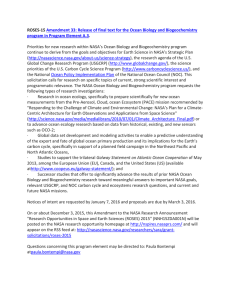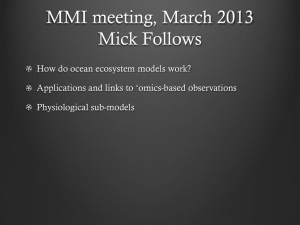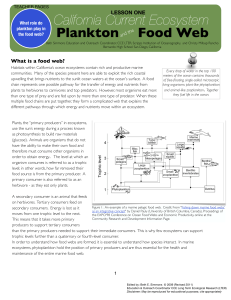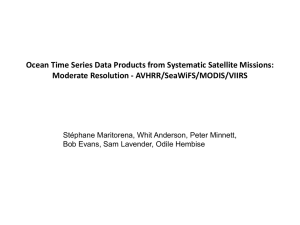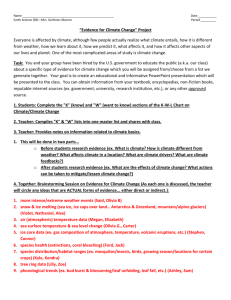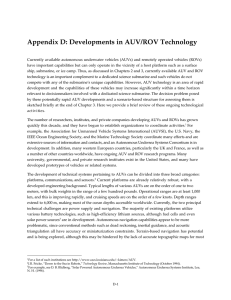Murray_Notes - EssentialVariables Session
advertisement
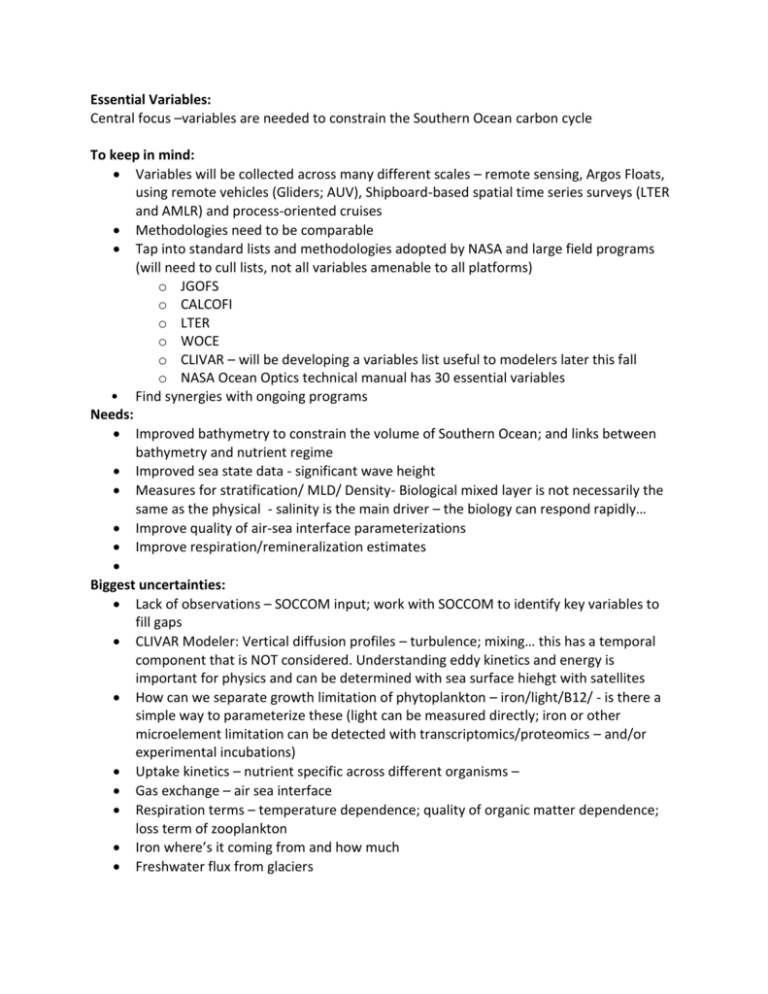
Essential Variables: Central focus –variables are needed to constrain the Southern Ocean carbon cycle To keep in mind: Variables will be collected across many different scales – remote sensing, Argos Floats, using remote vehicles (Gliders; AUV), Shipboard-based spatial time series surveys (LTER and AMLR) and process-oriented cruises Methodologies need to be comparable Tap into standard lists and methodologies adopted by NASA and large field programs (will need to cull lists, not all variables amenable to all platforms) o JGOFS o CALCOFI o LTER o WOCE o CLIVAR – will be developing a variables list useful to modelers later this fall o NASA Ocean Optics technical manual has 30 essential variables • Find synergies with ongoing programs Needs: Improved bathymetry to constrain the volume of Southern Ocean; and links between bathymetry and nutrient regime Improved sea state data - significant wave height Measures for stratification/ MLD/ Density- Biological mixed layer is not necessarily the same as the physical - salinity is the main driver – the biology can respond rapidly… Improve quality of air-sea interface parameterizations Improve respiration/remineralization estimates Biggest uncertainties: Lack of observations – SOCCOM input; work with SOCCOM to identify key variables to fill gaps CLIVAR Modeler: Vertical diffusion profiles – turbulence; mixing… this has a temporal component that is NOT considered. Understanding eddy kinetics and energy is important for physics and can be determined with sea surface hiehgt with satellites How can we separate growth limitation of phytoplankton – iron/light/B12/ - is there a simple way to parameterize these (light can be measured directly; iron or other microelement limitation can be detected with transcriptomics/proteomics – and/or experimental incubations) Uptake kinetics – nutrient specific across different organisms – Gas exchange – air sea interface Respiration terms – temperature dependence; quality of organic matter dependence; loss term of zooplankton Iron where’s it coming from and how much Freshwater flux from glaciers Environmental Variable Categories – and Key Variables How can we better constrain these variables across interannual, seasonal and regional contexts? Sea Ice parameters and measurements Carbon Export – 100 and 500 m (Clivar) Export (POC) DOC DIC Alkalinity Biological components of carbon Respiration Net Community Production (GPPRespiration) [at different depths] New Production Phytoplankton carbon Zooplankton carbon Bacterioplankton carbon Biology Size fractionated phytoplankton Major microbial functional/biogeochemical groups Ecological and/or ecosystem drivers of community structure (top down/bottom up) Biogeochemistry Uptake – ideally. Fe (other trace elements?) NO3, NO2, NH4, Norg Si PO4, Porg DO (and other dissolved gases) Physics MLD and water column structure Salinity Temperature Remote Sensing Sea surface height Sea surface chlorophyll SST Wind Sea ice Ocean color Heat flux CO2 NASA – Echo2 model – Global circulation model [ Mitchell/Manizza working with this model with JPL – to apply this in the Southern Ocean] NASA – GIS model PACE - hyperspectral – 7-8 nm UV and Vis/IR + Altimeters. Non-Carbon or Nutrient Chemistry O2/AOU Pigments Chemotaxonomy 14C, 18O Atmospheric Gases O2 Ar N 2O NO CH4 DMSO CO2 Particles/Aerosols Discussion Items and take home points 1. Export – To improve the understanding and input for models: Multiple depths, multiple methods (Thorium, Oxygen etc.) are needed. Refer to the literature protocols to determine these. Uncertainties large – take advantage of EXPORTS Science Plan. 2. Look at and utilize Southern Ocean Models (e.g. Oscar Scofield’s model he presented) as checks for parameters in addition to facilitating constraining uncertainties. Top down vs. bottom up control – and temporal changes? 3. Models: Need for coupling, put an atmospheric model on top of ecosystem models that consider major drivers (limitation – light/Fe etc.). Focus on variables important in the Southern Ocean – wind, surface roughness, etc. SOCCOM –NO3, O2, Biooptics – will go towards utilizing inverse model. What can “we” do to augment the floats? SOSE is large-scale. Modelers are not ready to deal with future influx of higherresolution satellite data. 4. Questions: What controls community structure? Use network models to associate structure across different trophic levels; then link to remote sensing optical/hyperspectral data. How important are coastal vs. open ocean carbon cycling processes? What do we need for upscaling and downscaling? 5. Observation ideas: Transects across the fronts/ get to sea ice-shelf. Moorings Under- ice work (AUV/ROV/Glider) Enhance atmospheric observations at seasonal, regional scales – work to determine how to do so possible to do economically, leveraging international collaboration, automated observation






